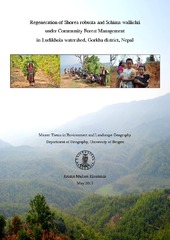| dc.description.abstract | Resource and forest management in Nepal: Resource management is of current global interest because of its role in sustaining natural resources and livelihood for future generations. Hardin's paper, the Tragedy of the Commons", served as a starting point to the wider discussion on challenges for sustainable resource management. Hardin's theory is widely cited in the context of forest management, especially to explain forest degradation, e.g. in the Himalaya where forest degradation has a long history. During the 1950s-1970s it became increasingly difficult to ignore the warnings of severe on-going deforestation in Nepal. Forests were nationalized and owned by the state and they were poorly, if at all, managed. In practice they were therefore commons' in the way that Hardin used the concept; an area of open access resources for anybody to use. The precarious situation pushed forth the formation of institutions and policies that aimed to secure forest sustainability by regulating forest-product outtake. Community Forestry (CF) management was introduced in the late 1970s. Rights to use forests were decentralized from top-down governmental management to bottom-up management by means of locally-run Community Forests (CFs). Theories, aims and hypotheses: Deforestation and forest degradation have shifted towards a stable or a growing forest cover in several areas. Contrary to Hardin's argument that commons' will be depleted if not managed by a public government system or private land tenure, Ostrom argues that communities are capable of managing resources in sustainable ways by self-regulating practices and social check-ups. I hypothesise that her argument is valid with changes in underlying human-ecological factors such as forest user-density and market proximity, i.e. I assume that forests can regenerate sustainably independently of the number of users per forest area, distance to the urban centre and the main district road. I test this by analysing the regeneration of Shorea robusta and Schima wallichii in six CFs located in Ludikhola watershed, Gorkha district, Nepal. The close located forests were heavily degraded when CF management was established c 30 years ago. Methods: I combined results from systematic forest sampling and interviews to determine if forest regeneration is sustainable under the current management regime. Physical and biological features were analysed in a total of 90 plots (10m10m) in a balanced design. Recruits were counted, and DBH of trees measured. I used univariate and multivariate statistics to analyse the quantitative data, whereas qualitative data were used to contextualize numerical results. Major results and conclusions: The CFs are regenerating in a sustainable manner. This is shown by reversed J-shaped size-class distributions and sufficient number of recruits. The environmental variables with the greatest impact on recruits indicate that both species are prone to disturbances related to land-use. Shorea robusta recruits decrease with denser canopy closure and more leaf litter on the ground. The intensity of lopping does not influence the number of recruits, but decreases seedling abundance; and number of recruits decreases in areas where many stems were cut. Environmental variables with an impact on Schima wallichii recruits are fewer, and the environmental variable that explains most of the variability within Schima wallichii recruits is degree... | en_US |
